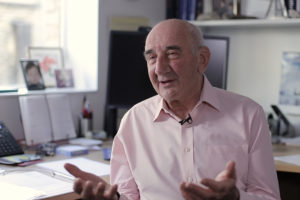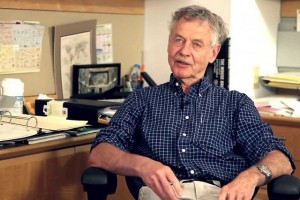Accelerated Ageing in COPD
Respiratory scientist Peter Barnes on cellular senescence, sirtuins and how can we reverse some of the chronic...
What processes take place in a bacteria population under antibiotic treatment? What important discovery made during World War II was forgotten? How can we circumvent the protection mechanisms used by bacteria populations? Professor of Biology at Northeastern University Kim Lewis explains the significance of a rediscovered phenomenon.
It’s in general a great idea to look for paradoxes when you are thinking about starting a new project because if there is a paradox that means that nobody has a clue about understanding the phenomenon. If you can come up with a good solution that means that you are on to something.
The paradox of chronic infections goes like this: you can take an antibiotic that kills the pathogen, lets us say, E. coli causes an infection, urinary tract infection. And the patient that was treated with this antibiotic did not get better – it’s a chronic relapsing infection. The pathogen is isolated, is tested on a Petri dish and this antibiotic prevents the growth of this pathogen into a colony on the Petri dish. Here is the paradox. The antibiotic is perfectly effective on a Petri dish and completely ineffective in the human infected with this pathogen.
This happens with each and every chronic disease. Some chronic diseases are completely untreatable in the West, in the developed countries: for example cystic fibrosis. Patients with cystic fibrosis produce a lot of mucus in the lung, get infected with Pseudomonas aeruginosa and this pathogen ultimately kills the patient after several decades and the only thing that antibiotics can do is to keep it at bay, to prevent it from blooming into very large massive cells. It helps the patient but ultimately does not prevent death.
One of the things that are associated with chronic infections is the biofilm. Once a bacterial cell forms a colony inside the body, it covers itself with a layer of exopolymer that protects it from the immune system. The first idea that people came up with is that the biofilm exopolymer prevents the colony from antibiotics. That did not turn out to be true because antibiotics do fuse freely into the biofilm, and of course they should because nutrients defuse into the biofilm, and antibiotics are about the same size of nutrients (that never made sense to me).
Then there is another sort of list of reasons that people came up with. And that list, when I looked at it, seemed to me like a typical attempt to sweep things under the rug instead of explaining them. The idea was that these components all taken together may explain the phenomenon. I’m not going to go through the list, because I don’t think it particularly interesting. We started by doing a simple experiment: testing the time-dependent killing of a bacterial biofilm in a test tube by an antibiotic. What we saw is that the bulk, the majority of cells, die rather rapidly, and then there’s a tiny part (maybe 1/10 000 to 1/100 000 cells) that remain intact and alive and are not killed by antibiotic.
When I first saw the result of that experiment, it was performed by a postdoc, a very good, talented young scientist, Alexei Brooun, I thought that he made a mistake and told him, that you need to redo the experiment, that it cannot possibly be the result because that means that in this very simple experiment we discovered the principle culprit of biofilm resistance to kill it, it is these invincible cells and people should have seen them before. It is not possible that we were the first ones, who did this elementary experiment. I asked him to repeat the experiment; he repeated and got exactly the same result. That made no sense to me – I figured every paper on biofilm should start with the introduction that says, “You know, you add antibiotics to biofilm and you hit upon this small population of invincible cells and that is the subject of the study.”
What we decided to do, we had a big stack of papers on biofilms and we split it in two, each of us got a half, we started leafing through them looking for the exact experiment that we did. We found it in four papers — the exact same experiments on bi-phasing killing with the small population of surviving cells. But people were focused on the majority of the cells, and what happens with them. Why – hard to tell.
Anyway, we published our first paper and said that here are the culprits, these are persister cells and actually persister cells were discovered in 1944 by a guy named Bigger (he was an Irishman working in England at the time at a military hospital). He was experimenting with penicillin that just became available at the time. What he noticed is that penicillin apparently sterilizes a culture of a pathogen Staphylococcus. From turbid the culture became transparent, but being a real scientist he took a droplet of that transparent liquid put it on a Petri dish and saw rare colonies arise. Not all cells were killed. Then he took those cells, reinoculated them and saw exactly the same thing: the culture lyses but again, a little part of it survives. He said “these are not mutants, these must be persisters, and this was very disappointing that penicillin does not sterilize the culture.”
That disappointment we share with all other antibiotics. Antibiotics do not sterilize persister cultures. Bigger’s work was forgotten — it was a curiosity, nobody paid attention. We rediscovered persisters in the biofilm, brought that old knowledge back. Bigger is the real pioneer; I hope that Ireland once at some point will put up a statue of Bigger at the University of Dublin. But for now there is quite a sizable field that studies persister сells that are responsible for biofilm tolerance to antibiotics.
One of the first things we discovered studying persisters that it is almost impossible to study, almost impossible to pin down what is it that happens to them that they become so different. So the standard approach to finding genes when you are studying a phenomenon is to mutagenize the population: treat it with some mutagen, you get mutants, then you analyze mutants for the absence of the feature you are interested in.
For example, let us find a mutant that makes no persister cells. That’s a standard question you will ask. And that was impossible to find. We could not find a mutant that makes no persister cells. What does that mean? That means that there more than one mechanism for making persister cells. These mechanisms are completely independent of one another: you knock out one mechanism, the persisters are still there. This is a standard tool of molecular genetics that we were deprived of because the tool is not working. Then the question is what to do?
We decided, we need to isolate persister cells, guessing that maybe these are dormants, so let us build isolation on this guess. They are dormant cells; they neither grow nor die in the presence of antibiotics. They might be dormant, and that is why they are tolerant to killing by antibiotics. What we did then, we took a fluorescent protein, green fluorescent protein, and put it under the control in the chromosome of an inducible promoter. What happens then is that, once that green fluorescent protein is synthesized, the cells are green and, if they continue to actively synthesize, they remain green. If for whatever reasons they stop synthesizing the green fluorescent protein and went into dormancy, the protein degrades and they become dim.
Persisters we figured, of course, if they’re going into dormancy, they’ll stop making the protein, they will be dim. We have an instrument which is called the cell sorter and it has a laser that looks at each and every sell individually and asks the question, “is it fluorescent or not?” If it’s fluorescent, it puts it into one test tube; if it’s not fluorescent, it puts it in another test tube. Now we have two test tubes: one with regular cells and another with dormant ones. Once we collected the dormant cells, we can expose them to antibiotic. We confirm that they are tolerant to killing – then we know that persisters are dormant. That also gave us an opportunity to do what we call transcriptome analysis to measure simultaneously the expression of all genes in the genome: what genes are up, what genes are down.
What we discovered when we look at genes that are overexpressed is that overexpressed were enigmatic genes present in all chromosomes of bacteria and called toxins-antitoxins. Here are genes that code for proteins that have a potential to stop important cellular functions. Nobody really understood why a cell would carry something that can stop protein synthesis or RNA synthesis or de-energize the cell. Now it became rather clear: the function of these so-called toxins is to stop important cellular functions, which will allow a small population of cells to become dormant and become specialized survivors. So when something unpleasant hits the population, like an antibiotic, these are going to be the only cells that will survive, and in case of chronic infections, they unfortunately will cause a chronic infection.
The more we understand about persisters and the mechanism of their formation, the more interesting and intricate mechanisms we learn, but we also realize that the more we learn, the less understanding of those mechanisms is useful in designing drugs. Because the perfect way to get a drug is, if you have one mechanism, which is conserved in all bacteria, then you can hit that mechanism and you got yourself a drug. That’s not going to work in the case of persisters. So the most valuable thing we learn, the most practically valuable thing we learn about persisters is what not to do. Do not do standard drug discovery because that is not going to work. So we have to rethink the paradigm about drug discovery of persisters and invent approaches that are very different from the way current antibiotics act.
One idea in going after compounds that can eliminate persisters is to adopt the properties of a very old antibiotic, Metronidazole that kills by different principle: it is not actually attack a specific target in the cell. Metronidazole was discovered by accident in the 50’s, people didn’t know, of course, at that time what it does, it was just efficacious at killing bacteria. Metronidazole itself has no activity, it is a pro drug, it gets into the bacterial cell, and it is reduced by a bacteria-specific enzyme, called nitrate reductase, into reactive molecules. That reactive molecule then hits completely unrelated targets: DNA, the membrane, other proteins. Of course, it is also effective in dormant cells because dormant cells have DNA, proteins, the membrane. We actually found that compounds like Metronidazole have the ability to kill persister cells. Limitation of Metronidazole is that it only acts against anaerobic bacteria and microaerophilic bacteria that express it. So we need to find better compounds like Metronidazole that would be converted into reactive compounds by enzymes that are present in aerobic cells.

Respiratory scientist Peter Barnes on cellular senescence, sirtuins and how can we reverse some of the chronic...

Biologist Rudolf Jaenisch on invention of IPS cells, the epigenetic state of the genes, and making a liver in ...

Biologist Maria Sinetova about a beautiful and sometimes dangerous phenomenon of glowing of dinoflagellates